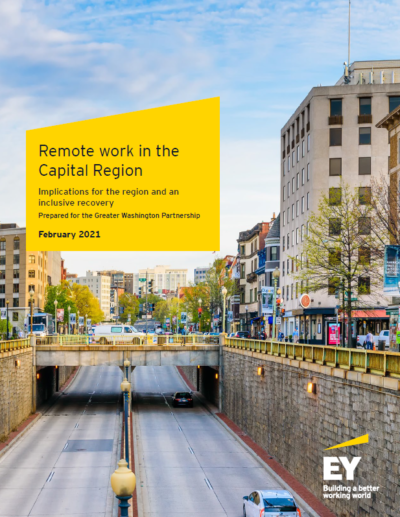Remote work in the Capital Region
Publish Date: February 2021

 Download Report »
Download Report »
The COVID-19 pandemic has accelerated the adoption of remote work across industries and occupations, allowing remote-capable employees to work from the comfort and safety of their homes. While the COVID-19-era prevalence of remote work will likely not be maintained once the pandemic has subsided, data collected through external surveys as well as the Greater Washington Partnership (the Partnership) and EY Capital COVID-19 Snapshot shows greater levels of remote working will continue even after herd immunity is reached, relative to pre-COVID-19 levels.
If a quarter of the employees capable of working remotely continue to do so after the pandemic, the impact of this shift will be felt beyond just those working remotely. This new way of working may impact migration trends throughout the region, commuting and transit patterns, the demand for goods and services provided by smaller businesses, and employment and career opportunities for both remote and non-remote workers. To address these changes, policymakers and community leaders need to understand the potential for sustained remote work in the Capital Region as well as the benefits and challenges it will present.
The increased prevalence of remote work is expected to disproportionately impact the region’s most vulnerable and underserved communities. Better understanding the differential impacts of these shifts on distinct communities will allow leaders to develop targeted policies and approaches that put equity at the center and promote an inclusive economic recovery.
Ernst & Young LLP (EY US) conducted this study at the request of the Partnership to assess the population and makeup of remote-capable jobs in the Capital Region, the degree to which employees in these positions might work remotely and the potential impacts of sustained remote work scenarios on the region’s transportation system, smaller businesses and non-remote workers. For the purposes of this study, the Capital Region is defined as the Baltimore-Columbia-Towson, MD; Richmond, VA; and Washington-Arlington-Alexandria, DC-VA-MDWV metropolitan statistical areas, which, at this scale, represent the third-largest economy in the US and seventh-largest in the world with more than 10 million residents, 188,000 employers and 5 million workers.
On March 9 Carmine Di Sibio, Global Chairman & CEO of EY joined JB Holston to discuss the COVID-19-era prevalence of remote work in the Capital Region. While this will likely not be maintained once the pandemic has subsided, data collected through external surveys and our COVID-19 Snapshot shows more significant levels of remote working will continue even after herd immunity is reached, relative to pre-COVID-19 levels. Catch the conversation!